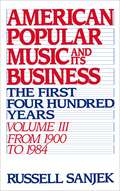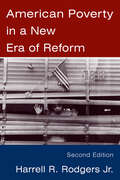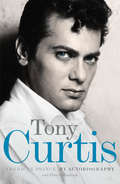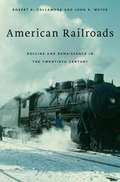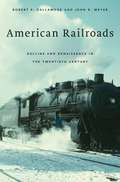- Table View
- List View
American Popular Music and Its Business: The First Four Hundred Years, Volume III: From 1900-1984
by the late Russell SanjekThis volume focuses on developments in the music business in the twentieth century, including vaudeville, music boxes, the relationship of Hollywood to the music business, the "fall and rise" of the record business in the 1930s, new technology (TV, FM, and the LP record) after World War II, the dominance of rock-and-roll and the huge increase in the music business during the 1950s and 1960s, and finally the changing music business scene from 1967 to the present, especially regarding government regulations, music licensing, and the record business.
American Popular Music and Its Business in the Digital Age: 1985-2020
by Rick SanjekAmerican Popular Music and Its Business in the Digital Age: 1985-2020 by Rick Sanjek is the sequel to his father Russell Sanjek's American Popular Music and Its Business: the First 400 Years. This book offers a detailed and objective history of the popular music industry from the introduction of the compact disc to the shift to streaming, with particular emphasis on the creators, the consumers, and the music business professionals who, in Sanjek's telling, form the three major axes of the industry. Each of the book's three sections--1985-1995, 1996-2006, and 2007-2019--has five chapters covering the same areas and issues. The first chapter in each section outlines the competition between the Big Six music conglomerates, their corporate structures, leadership, finances, and market share. The second chapter traces the synergy between the labels, the retail sector, radio, and the trade magazines whose charts are the pacemaker for the entire industry. Third comes music publishing, licensing, copyright, and legal issues including legislation, litigation, and infringement, followed by a focus on creators and how they earn their money. Each final chapter examines how, how much, and where consumers--who lead in adopting new technology--spend their money. Underlying it all is an insider's perspective on the role that the CD, Napster, Apple, Spotify, YouTube, SoundScan, electronic ticketing, and other innovations had in redefining the business structure and revenue flow of the entire industry. Digital technology also affected the regulations, contracts, and financial transactions that define the complex business of music, as live performance transitioned from clubs, concert halls, and theaters to arenas, amphitheaters, and stadiums. Concurrently, recorded music evolved from analog to digital sound carriers through MP3 downloads and then to on-demand streaming files, ultimately affecting consumers, creators, and the music business infrastructure that connects them. Finally, an epilogue includes the effects of COVID-19 in 2020 on all involved, closing with a glimpse into the digital future with the emergence of TikTok, livestreaming, immersive media, and artificial intelligence.
American Popular Music and Its Business in the Digital Age: 1985-2020
by Rick SanjekAmerican Popular Music and Its Business in the Digital Age: 1985-2020 by Rick Sanjek is the sequel to his father Russell Sanjek's American Popular Music and Its Business: the First 400 Years. This book offers a detailed and objective history of the popular music industry from the introduction of the compact disc to the shift to streaming, with particular emphasis on the creators, the consumers, and the music business professionals who, in Sanjek's telling, form the three major axes of the industry. Each of the book's three sections--1985-1995, 1996-2006, and 2007-2019--has five chapters covering the same areas and issues. The first chapter in each section outlines the competition between the Big Six music conglomerates, their corporate structures, leadership, finances, and market share. The second chapter traces the synergy between the labels, the retail sector, radio, and the trade magazines whose charts are the pacemaker for the entire industry. Third comes music publishing, licensing, copyright, and legal issues including legislation, litigation, and infringement, followed by a focus on creators and how they earn their money. Each final chapter examines how, how much, and where consumers--who lead in adopting new technology--spend their money. Underlying it all is an insider's perspective on the role that the CD, Napster, Apple, Spotify, YouTube, SoundScan, electronic ticketing, and other innovations had in redefining the business structure and revenue flow of the entire industry. Digital technology also affected the regulations, contracts, and financial transactions that define the complex business of music, as live performance transitioned from clubs, concert halls, and theaters to arenas, amphitheaters, and stadiums. Concurrently, recorded music evolved from analog to digital sound carriers through MP3 downloads and then to on-demand streaming files, ultimately affecting consumers, creators, and the music business infrastructure that connects them. Finally, an epilogue includes the effects of COVID-19 in 2020 on all involved, closing with a glimpse into the digital future with the emergence of TikTok, livestreaming, immersive media, and artificial intelligence.
American Poverty in a New Era of Reform
by Harrell R. RodgersThis new edition of American Poverty in a New Era of Reform provides a comprehensive examination of the extent, causes, effects, and costs of American poverty nearly ten years after the passage of the Personal Responsibility and Work Opportunity Reconciliation Act (PRWORA) in 1996. The author includes the most current available demographic, budget, evaluation, and program data to evaluate the impact of this sweeping legislation on federal and state policies, as well as on poverty populations. This revised edition takes into account the economic slowdown that took place in 2001 through 2003. It examines the state decisions about how to implement PRWORA, and how changes have affected the poverty population and overall welfare system. The author identifies the positive implications of welfare reform along with problems that must be addressed. New features for this edition include an appendix of Internet sources a state-by-state tables of poverty rates.
American Poverty in a New Era of Reform
by Harrell R. RodgersThis new edition of American Poverty in a New Era of Reform provides a comprehensive examination of the extent, causes, effects, and costs of American poverty nearly ten years after the passage of the Personal Responsibility and Work Opportunity Reconciliation Act (PRWORA) in 1996. The author includes the most current available demographic, budget, evaluation, and program data to evaluate the impact of this sweeping legislation on federal and state policies, as well as on poverty populations. This revised edition takes into account the economic slowdown that took place in 2001 through 2003. It examines the state decisions about how to implement PRWORA, and how changes have affected the poverty population and overall welfare system. The author identifies the positive implications of welfare reform along with problems that must be addressed. New features for this edition include an appendix of Internet sources a state-by-state tables of poverty rates.
American Power after the Financial Crisis (Cornell Studies in Money)
by Jonathan KirshnerThe global financial crisis of 2007–2008 was both an economic catastrophe and a watershed event in world politics. In American Power after the Financial Crisis, Jonathan Kirshner explains how the crisis altered the international balance of power, affecting the patterns and pulse of world politics. The crisis, Kirshner argues, brought about an end to what he identifies as the "second postwar American order" because it undermined the legitimacy of the economic ideas that underpinned that order—especially those that encouraged and even insisted upon uninhibited financial deregulation. The crisis also accelerated two existing trends: the relative erosion of the power and political influence of the United States and the increased political influence of other states, most notably, but not exclusively, China. Looking ahead, Kirshner anticipates a "New Heterogeneity" in thinking about how best to manage domestic and international money and finance. These divergences—such as varying assessments of and reactions to newly visible vulnerabilities in the American economy and changing attitudes about the long-term appeal of the dollar—will offer a bold challenge to the United States and its essentially unchanged disposition toward financial policy and regulation. This New Heterogeneity will contribute to greater discord among nations about how best to manage the global economy. A provocative look at how the 2007–2008 economic collapse diminished U.S. dominance in world politics, American Power after the Financial Crisis suggests that the most significant and lasting impact of the crisis and the Great Recession will be the inability of the United States to enforce its political and economic priorities on an increasingly recalcitrant world.
American Power and Policy (Archival Insights into the Evolution of Economics)
by R. LeesonUses archival evidence to provide unique insights into US economics, focusing on the origins of the IMF, building a multilateral strategy for the US, the Great Inflation of the 1970s, and on Marriner S. Eccles, Lauchlin Currie, Allyn Young, John H. Williams and Arthur I. Bloomfield.
American Power and the Prospects for International Order
by Simon BromleyThe turn of the century has seen the US greatly enhance its military supremacy across the world. It has also played a key role in shaping the international economic order. More recently, however, its world-wide economic domination has started to diminish as other regions and countries have become globally important players. Simon Bromley brings a fresh perspective to these issues, arguing that it is as yet unclear whether the US will be capable of rising to the challenges posed by the new world order. He carefully examines the intricacies of these debates including the American ideology of a liberal international order and the relation of this to the Bush doctrine; US power in the transatlantic arena and US-European integration in relation to the EU and NATO; and the geo-politics of oil. He looks at a range of challenges to US dominance, including the weakening of the dollar; the rapid growth and industrialization of Asia; and the strengths and weaknesses of Bush's foreign policy. This book is set to spark debate amongst students and scholars of international politics, as well as appealing to anyone interested in the changing shape of the international order.
American Power and the Prospects for International Order
by Simon BromleyThe turn of the century has seen the US greatly enhance its military supremacy across the world. It has also played a key role in shaping the international economic order. More recently, however, its world-wide economic domination has started to diminish as other regions and countries have become globally important players. Simon Bromley brings a fresh perspective to these issues, arguing that it is as yet unclear whether the US will be capable of rising to the challenges posed by the new world order. He carefully examines the intricacies of these debates including the American ideology of a liberal international order and the relation of this to the Bush doctrine; US power in the transatlantic arena and US-European integration in relation to the EU and NATO; and the geo-politics of oil. He looks at a range of challenges to US dominance, including the weakening of the dollar; the rapid growth and industrialization of Asia; and the strengths and weaknesses of Bush's foreign policy. This book is set to spark debate amongst students and scholars of international politics, as well as appealing to anyone interested in the changing shape of the international order.
American Power, the New World Order and the Japanese Challenge
by W. NesterThis book analyzes US-Japan relations amidst the changing nature of power and international relations. Chapters explore the relative successes and shortcomings of American liberalism and Japanese Neomercantilism, the bilateral trade duels over finance, high technology, agriculture, and other industries, and the costs and benefits of foreign investment and military spending. The book concludes with suggestions for a systemic and radical overhaul of American policies toward itself, the global economy, and Japan.
American Pragmatism and Organization: Issues and Controversies
by Nick RumensEmerging during the late nineteenth century in the diverse scholarship of US commentators such as Charles Sanders Peirce, William James and John Dewey, American pragmatism shaped many intellectual currents within a range of disciplines including politics, education, administrative science and religion. Despite attracting attention and interest due to its conceptualization of theory, in terms of its practical consequences for improving the human condition, American pragmatism struggled to maintain its influence and suffered a hiatus until it experienced a renaissance within scholarly circles during the 1970s. While renewed interest in American pragmatism continues to grow, with some scholars distinguishing between classical, neo and new forms of pragmatism, it is only relatively recently that organization studies scholars have drawn upon American pragmatist philosophies for shedding new light on aspects of contemporary organizational life. This edited collection builds on this emergent literature in an engaging and scholarly manner. American Pragmatism and Organization is a ground-breaking collection and distinctive in its book-length treatment of American pragmatism as a relevant resource for analysing organisations. It draws together an international body of research focused on the interconnections and interplay between American pragmatism and organizational phenomena, explores the theoretical possibilities afforded by pragmatist thinking for understanding organization, and illuminates the practical advantages of doing so.
American Pragmatism and Organization: Issues and Controversies
by Nick RumensEmerging during the late nineteenth century in the diverse scholarship of US commentators such as Charles Sanders Peirce, William James and John Dewey, American pragmatism shaped many intellectual currents within a range of disciplines including politics, education, administrative science and religion. Despite attracting attention and interest due to its conceptualization of theory, in terms of its practical consequences for improving the human condition, American pragmatism struggled to maintain its influence and suffered a hiatus until it experienced a renaissance within scholarly circles during the 1970s. While renewed interest in American pragmatism continues to grow, with some scholars distinguishing between classical, neo and new forms of pragmatism, it is only relatively recently that organization studies scholars have drawn upon American pragmatist philosophies for shedding new light on aspects of contemporary organizational life. This edited collection builds on this emergent literature in an engaging and scholarly manner. American Pragmatism and Organization is a ground-breaking collection and distinctive in its book-length treatment of American pragmatism as a relevant resource for analysing organisations. It draws together an international body of research focused on the interconnections and interplay between American pragmatism and organizational phenomena, explores the theoretical possibilities afforded by pragmatist thinking for understanding organization, and illuminates the practical advantages of doing so.
American Prince: My Autobiography
by Peter Golenbock Tony CurtisHe has appeared in over a hundred films. Elvis copied his looks. The Beatles put him on the cover of Sgt. Pepper. Tony Curtis is without question a Hollywood legend and part of its Golden Age. In American Prince he tells the whole story, from his hard-knock childhood growing up in the Bronx to his wild days as a Hollywood playboy, his destructive drug addiction and his life now as an artist in his eighties. He talks frankly about the people he has known during his long and illustrious career, from the studio owners and directors to his famous friends, such as Jack Lemmon, Cary Grant and James Dean, and the women in his life, including Janet Leigh and Natalie Wood.Forthright and enthralling, and sparing no detail and no ego, American Prince is the true record of a life lived to the full.
American Promise: Equal Justice and Economic Opportunity
by Arthur I. BlausteinThis forcefully argued and carefully documented report by the National Advisory Council on Economic Opportunity criticizes the Reagan Economic Recovery Program on the basis that it separates economic theory from social policy, pursuing the former at the expense of the latter, which hurts the poor and could lead to social chaos. This controversial volume also argues that the current policy proposals for the 1980s ignore national standards of responsi-bility and accountability.The report focuses on five aspects of American social, economic, and po-litical life: unemployment and inflation; federal antipoverty programs and policies; the changing face of poverty and the myths that affect the poor; the role of voluntary associations and the shared moral values of our society; the particular problems of family, child care, and welfare for women in poverty.
American Promise: Equal Justice and Economic Opportunity
by Arthur I. BlausteinThis forcefully argued and carefully documented report by the National Advisory Council on Economic Opportunity criticizes the Reagan Economic Recovery Program on the basis that it separates economic theory from social policy, pursuing the former at the expense of the latter, which hurts the poor and could lead to social chaos. This controversial volume also argues that the current policy proposals for the 1980s ignore national standards of responsi-bility and accountability.The report focuses on five aspects of American social, economic, and po-litical life: unemployment and inflation; federal antipoverty programs and policies; the changing face of poverty and the myths that affect the poor; the role of voluntary associations and the shared moral values of our society; the particular problems of family, child care, and welfare for women in poverty.
American Protestants and TV in the 1950s: Responses to a New Medium (Religion/Culture/Critique)
by M. RosenthalAmericans in the 1950s faced the challenge of negotiating the new medium's place in the home and in American culture in general. Using the American Protestant experience of the introduction of television, Rosenthal illustrates the importance of the interplay between a new medium and its users.
American Railroads: Decline And Renaissance In The Twentieth Century
by Robert E. GallamoreOverregulated and displaced by barges, trucks, and jet aviation, railroads fell into decline. Their misfortune was measured in lost market share, abandoned track, bankruptcies, and unemployment. Today, rail transportation is reviving. American Railroads tells a riveting story about how this iconic industry managed to turn itself around.
American Railroads: Decline And Renaissance In The Twentieth Century
by Robert E. GallamoreOverregulated and displaced by barges, trucks, and jet aviation, railroads fell into decline. Their misfortune was measured in lost market share, abandoned track, bankruptcies, and unemployment. Today, rail transportation is reviving. American Railroads tells a riveting story about how this iconic industry managed to turn itself around.
American Rubber Workers & Organized Labor, 1900-1941 (PDF)
by Daniel NelsonIn 1900 the manufacture of rubber products in the United States was concentrated in several hundred small plants around New York and Boston that employed low-paid immigrant workers with no intervention from unions. By the mid-1930s, thanks to the automobile and the Depression, production was concentrated in Ohio, the labor force was largely native born and highly paid, and labor organizations had a decisive influence on the industry. Daniel Nelson tells the story of these changes as a case study of union growth against a background of critical developments in twentieth-century economic life.The author emphasizes the years after 1910, when a crucial distinction arose between big, mass-production rubber producers and those that were smaller and more labor intensive. In the 1930s mass-production workers took the lead in organizing the labor movement, and they dominated the international union, the United Rubber Workers, until the end of the decade. Professor Nelson discusses not only labor's triumph over adversity but also the problems that occurred with union victories: the flight of the industry to low-wage communities in the South and Midwest, internal tensions in the union, and rivalry with the American Federation of Labor. The experiences of the URW in the late 1930s foreshadowed the longer-term challenges that the labor movement has faced in recent decades.Originally published in 1988.The Princeton Legacy Library uses the latest print-on-demand technology to again make available previously out-of-print books from the distinguished backlist of Princeton University Press. These editions preserve the original texts of these important books while presenting them in durable paperback and hardcover editions. The goal of the Princeton Legacy Library is to vastly increase access to the rich scholarly heritage found in the thousands of books published by Princeton University Press since its founding in 1905.
The American Savings and Loan Industry, 1831-1935 Vol 1
by David L MasonThe American savings and loan industry began in the 1830s to help people of modest financial means buy a home. Despite the long history of the industry there has been limited scholarly work done on its early years. This collection allows an insight into the place of the savings and loans industry within the wider context of American society.
The American Savings and Loan Industry, 1831-1935 Vol 1
by David L MasonThe American savings and loan industry began in the 1830s to help people of modest financial means buy a home. Despite the long history of the industry there has been limited scholarly work done on its early years. This collection allows an insight into the place of the savings and loans industry within the wider context of American society.
The American Savings and Loan Industry, 1831-1935 Vol 2
by David L MasonThe American savings and loan industry began in the 1830s to help people of modest financial means buy a home. Despite the long history of the industry there has been limited scholarly work done on its early years. This collection allows an insight into the place of the savings and loans industry within the wider context of American society.
The American Savings and Loan Industry, 1831-1935 Vol 2
by David L MasonThe American savings and loan industry began in the 1830s to help people of modest financial means buy a home. Despite the long history of the industry there has been limited scholarly work done on its early years. This collection allows an insight into the place of the savings and loans industry within the wider context of American society.
The American Savings and Loan Industry, 1831-1935 Vol 3
by David L MasonThe American savings and loan industry began in the 1830s to help people of modest financial means buy a home. Despite the long history of the industry there has been limited scholarly work done on its early years. This collection allows an insight into the place of the savings and loans industry within the wider context of American society.
The American Savings and Loan Industry, 1831-1935 Vol 3
by David L MasonThe American savings and loan industry began in the 1830s to help people of modest financial means buy a home. Despite the long history of the industry there has been limited scholarly work done on its early years. This collection allows an insight into the place of the savings and loans industry within the wider context of American society.
